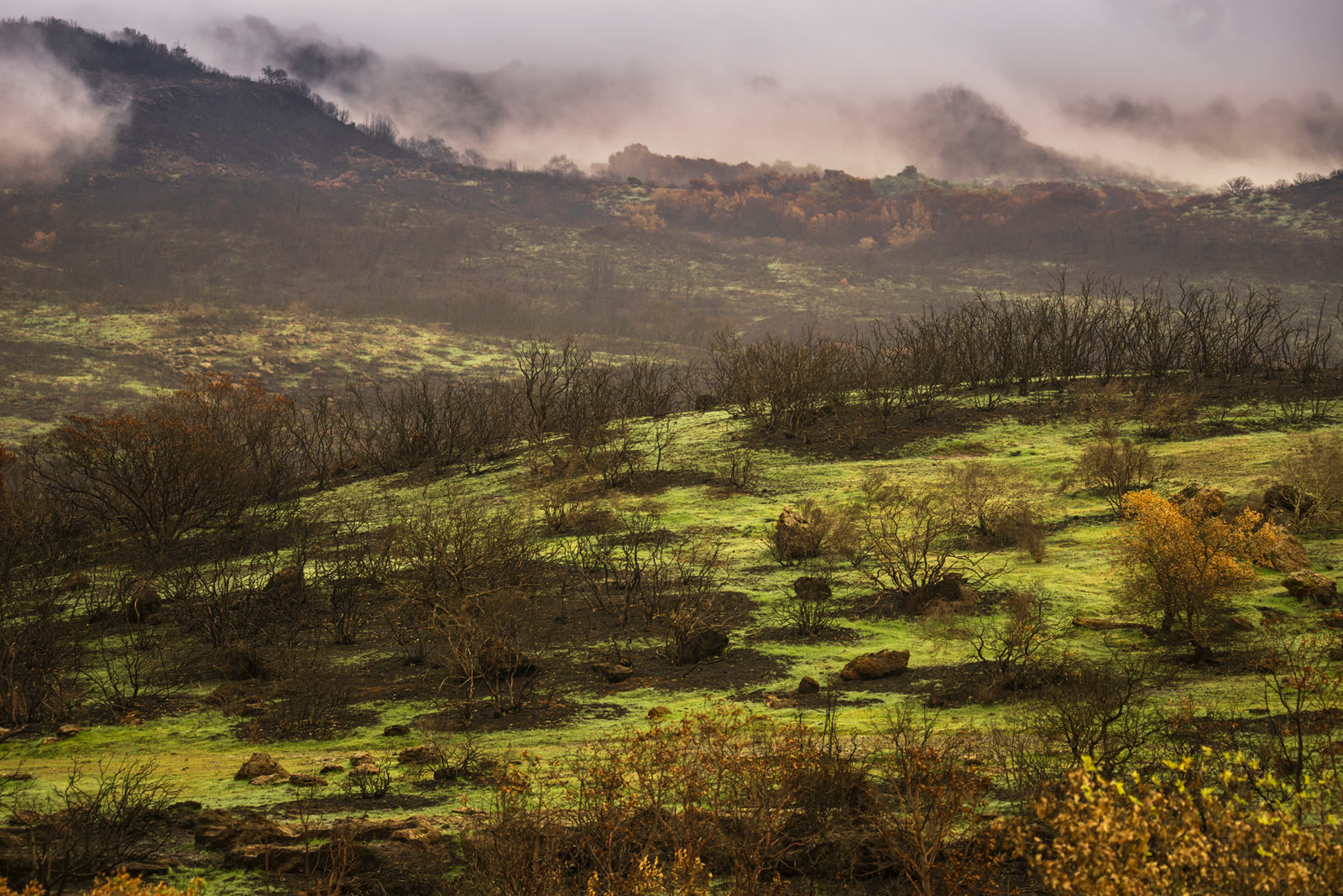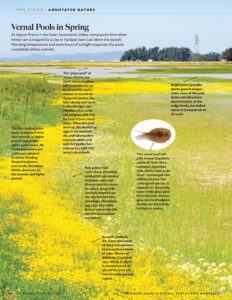Only weeks after the destructive forces of the North Bay fire last fall, new life started to emerge on the land. Viewed across the more than 200,000 acres of blackened landscape, some burn patterns were familiar, like the 1981 Atlas Peak Fire’s imprint, while others wandered. Entirely new areas were also torched—for instance, the Sonoma Mountain area, formerly untouched by fire in modern record-keeping. A unique combination of Diablo winds, fire weather, vegetation age, and sheer chaos created an unprecedented burn perimeter that will surely lead to botanical surprises this spring.
In some areas, the fire seemed to move slowly and quietly, only burning the forb (non-woody) layer nearest the earth and lightly scarring massive oak trunks. These sites show a low burn severity, which will likely yield a vegetation community very similar to what existed the preceding year. In other areas, the fire severity was extreme, erasing nearly all above-ground biomass and often leaving a gray pile of ash. Manzanitas, ceanothus, and a suite of surprising fire followers can erupt from these more severely burned areas. The intensity of the burn on the landscape, and its vegetation, greatly influences which species awaken where.
The annual fire followers always steal the show in the first year after a moderate- to high-severity burn. Seeds lying dormant in the soil, sometimes for nearly 100 years, await their cue to germinate. An admired fire follower, the sunshine-colored whispering bells (Emmenanthe penduliflora), commonly carpets moderate- and high-severity burns in Southern California, covering blackened soil with pale and golden hues. It will likely make an appearance in the North Bay this spring (as it did the first spring after the 2013 Morgan Fire on Mount Diablo).
Another notable fire follower, blueblossom (Ceanothus thyrsiflorus), is a fast-growing shrub that germinates in high-severity burn areas. It replaces stands of coastal scrub and other shrubland types. Although annuals are typically associated with burned areas, this perennial makes a longer home on the landscape; we should be seeing it for 10 to 20 years after the fires. The blueblossom’s perfume is intoxicating to people and pollinators alike, especially when it forms dense stands in steep gullies and on ridges.
A duet of flowering plants that often emerge together after fires is the sky lupine (Lupinus bicolor) and California poppy (Eschscholzia californica). This pair particularly benefits from low-severity burns where fire has moved through the landscape quickly; the contrasting charred black remains combined with the bluish-purple and orange blossoms make for fantastic post-fire imagery.
Fire is historically unusual in the Bay Area, only naturally occurring once every 50 to 100 years (although California Indians burned areas more routinely). This long pause between burn events makes some fire followers unique and rare in our area. Such plants require fire to stimulate their germination in tandem with the abundance of nutrients and clearing of vegetation. The disturbance created by fire on the land is critical to conserving much of our rare flora, and yet our protected habitats are no longer subject to the landscape-scale disturbance that might clear the way for those early succession species to thrive.
Resprouters are a unique group of hardy, resilient plants often able to survive even the hottest of fires; they tough it out and then quickly rebound. Traits making this possible include thickened bark; a swollen, bud-filled root crown (lignotuber) that allows resprouting, and expansive root systems that store carbon. In particular, live oaks, cottonwoods, coffeeberry, toyon, and some (not all) manzanitas can stump-resprout and then make use of the increased light and nutrient-rich ash to grow and recover with amazing speed. These plants are likely the single most important means of preventing soil erosion after a fire, since their extensive belowground root networks in symbiotic relationship with fungi (mycorrhizae) create an effective soil security net.
As we continue to learn to live with fire in the Bay Area, how can land managers and residents embrace making space for botanical wonder? Is it possible to preserve fire-adapted systems near the wildland-urban interface? I certainly hope so, because one of the most destructive forces of nature also gives birth to some incredible displays of beauty, evolutionary adaption, and wildlife persistence, creating a space for wonder to occur.
Lech Naumovich is the executive director of the Golden Hour Restoration Institute. Read more for a treasure-hunt list of rare and unique plants to look for in the North Bay this spring.





